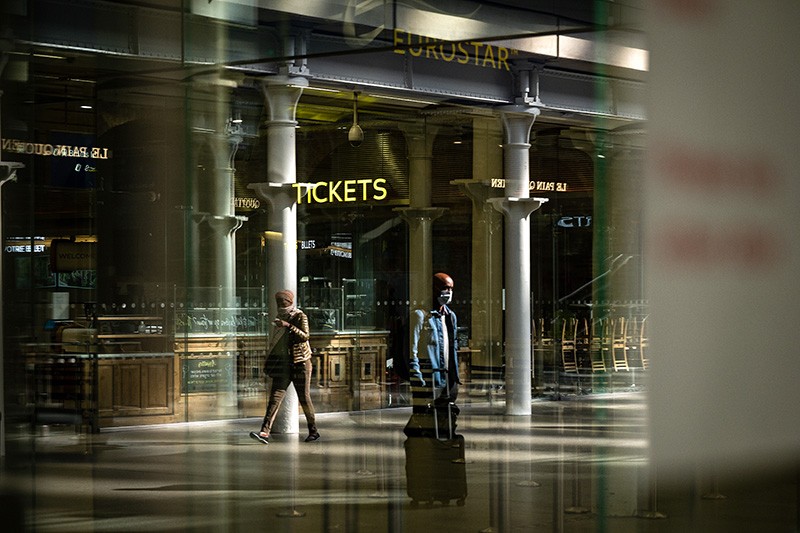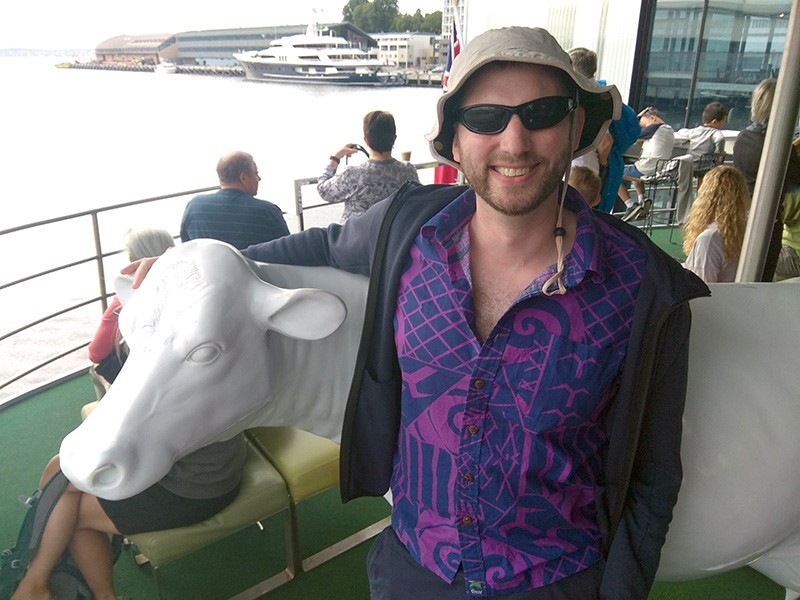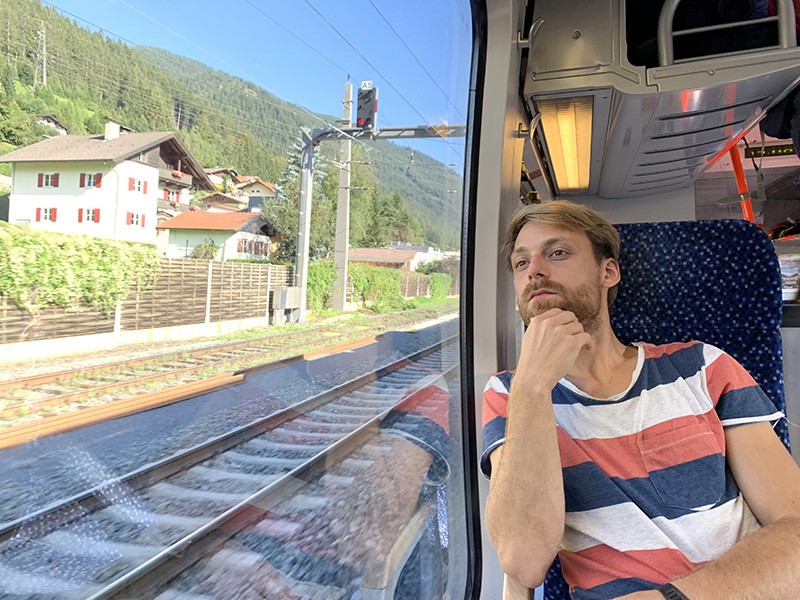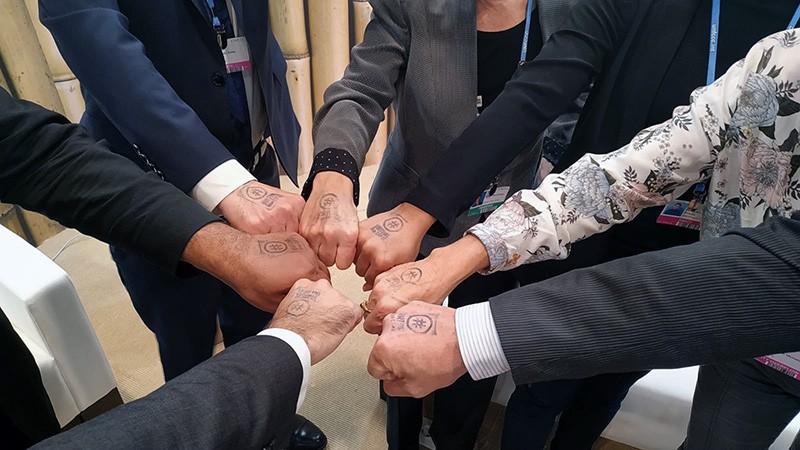In 2018, social scientist Roger Tyers pledged to stop flying for work and leisure. Soon afterwards, he won a research fellowship that included fieldwork in China. So he decided to take the train from Southampton to Shanghai, a journey of almost two weeks.
“I used to fly a lot,” says Tyers, now at the University of Nottingham, UK. His perspective changed when he read a 2018 report by the Intergovernmental Panel on Climate Change warning that unprecedented societal changes would be needed if humanity wanted to achieve the aims of the Paris climate agreement and keep global warming to 1.5 °C above pre-industrial levels. “That really brought home to me the urgency of climate change and how we need to make big changes in our behaviour,” he says, “including flying less.”
Tyers’s trip took him seven weeks, including fieldwork and train travel there and back. He calculates that it generated just 10% of the emissions that the equivalent flights would, which pleases him, even though his train tickets came close to three times the price of the equivalent flights. “I don’t expect everybody to be taking the train to China to do fieldwork,” he says. “But I think that as academics we can do a little bit better.”
Tyers is one of many climate scientists who are advocating for less air travel and following their own advice. Today, as the coronavirus continues to ravage much of the world, Tyers’s concerns have receded — at least temporarily — because nearly all conferences and meetings have pivoted to virtual models. Researchers throughout the world have learnt to embrace technology-based solutions for connecting.
But the carbon-footprint issue will remain in the long term. Once the pandemic is brought to heel, scientists will again grapple with how to reconcile the need to fly to meetings and fieldwork sites with their desire to limit — if not eliminate — air travel. A study in October showed that climate scientists tend to fly more often for work compared with their peers (L. Whitmarsh et al. Glob. Environ. Change 65, 102184; 2020), because of their remote fieldwork locations and their travel to international conferences, including those addressing climate-change mitigation.
Many feel strongly that virtual networking cannot adequately replace actual face-to-face time, and that opportunities to meet in person with peers and senior colleagues in their speciality are essential for career advancement.
Yet they point out that climate change is already having devastating effects. The past 12 months have brought record-high temperatures and vast wildfires on the US west coast, as well as increases in the frequency and ferocity of typhoons in Asia, a brutal drought in southern Africa, record flooding in Sudan, numerous back-to-back tropical storms and a record-breaking number of hurricanes in the Atlantic Ocean.
So what do climate scientists advise? There are multiple ways, they say, to connect with colleagues, collaborators, peers and others without boarding an aeroplane. Some are encouraging conference organizers to continue to offer virtual versions of all sessions, noting that attendance numbers rose dramatically for many conferences that went online-only last year. Virtual conferences also assist the participation of researchers who might lack the funds or visas to fly to international meetings, and they can be more accessible for people with disabilities.
Others are calling for a regular series of webinars to help people connect virtually. Many researchers were already using video platforms such as Google Meet, Zoom and Skype for meetings, as well as text and messaging platforms such as Slack and Twitter for networking and posting updates and articles.
Pack it in
Perhaps counter-intuitively, climate scientist Katharine Hayhoe says that she needs to fly to spread the message about climate change. But to keep her carbon footprint to a minimum and maximize the efficiency of her travel, she packs as many events as she can into one region. In a trip to Alaska in September 2019, she spoke at 29 events and meetings in the space of six days.
Hayhoe, a co-director of the Texas Tech University Climate Center in Lubbock, advises early-career researchers to fill their trips with as many networking opportunities as possible. “At the beginning of your career, meeting people face-to-face is really important,” she says. “If you go to a scientific conference, make the most of it: don’t present your poster or paper and leave. Look up ahead of time who’s going to be there, schedule coffees and lunches and breakfasts. Use every minute of your travel to maximize effectiveness.”
To bring down her carbon footprint, Hayhoe purchases carbon offsets from a programme that invests in local environmental projects in countries such as Kenya, Ghana and Mexico. Stephen Flood, who researches climate at University College Cork in Ireland, has a similar strategy. He prefers to “sail and rail” when feasible. But when flying is unavoidable, he buys carbon offsets.
Kim Cobb, who researches climate-change solutions at the Georgia Institute of Technology in Atlanta, agrees that in-person time is imperative for junior researchers. Cobb, who has also pledged to go flight-free, wants conferences to adopt a hub model, in which one large conference is replaced by several smaller meetings held simultaneously on different continents. Scientists would then travel by train to their nearest meeting, and the hubs would be connected to each other virtually. To account for differing time zones, she suggests that scientists exchange content and discuss it virtually at pre-arranged times. Alternatively, she says, small groups of scientists who are in compatible time zones could meet virtually. “I can convene with 50 of the world’s experts on my sub-discipline,” she says, “but there is equal and different value in convening with 50 climate scientists in one area and exploring ways to collaborate and share findings.”
Another advocate of the virtual approach is Milan Klöwer, who studies climate models at the University of Oxford, UK. He calculated the travel-related carbon footprint of the American Geophysical Union meeting in San Francisco, California, in December 2019, and found that 28,000 scientists travelled a total of 285 million kilometres, emitting the equivalent of 80,000 tonnes of carbon dioxide. He estimates that moving the meeting to the more central location of Chicago, Illinois, would reduce emissions by 12%. And holding the conference there biennially, rather than annually, and encouraging the 36% who would have to travel farthest to participate virtually, would reduce the travel footprint by 90% (M. Klöwer et al. Nature 583, 356–359; 2020). Furthermore, he noted that attendance for the May 2020 annual meeting of the European Geosciences Union ballooned to 26,000 after it became online-only, up from a typical attendance of 16,000.
Klöwer, who flies only when it is unavoidable, says that his own networking efforts accelerated when he began to attend more virtual meetings. “Have an active presence on Twitter,” he advises. “Engage with people, write them e-mails, ask for virtual seminars.” He also recommends organizing a monthly seminar series in which speakers are connected by software such as Zoom and the video chat is live-streamed through YouTube.
Social platforms
Slack groups are another way to connect virtually, says Divya Persaud, a planetary scientist at University College London. She is in a Slack group for people from minority ethnic backgrounds who study science, technology, engineering or mathematics. “We share opportunities, tips and events, and seek advice from other people, and that’s been really great for networking,” she says. Persaud also co-organized an experimental virtual conference called Space Science in Context in May 2020. Speakers recorded their talks in advance so that attendees could watch them and then ask questions at scheduled Zoom sessions. “It was a warm, inviting space,” Persaud says. “We had a lot of concurrent conversations happening in the chats during the live panels, and some really excellent discussions during the poster sessions, which can be lacking at in-person conferences, particularly for women and minority scholars.”
Ibukun Jacob Adewumi, director of international partnerships for the African Marine Environment and Sustainability Initiative in Paris, recommends organizing small meetings of two or three people in a laboratory, and then connecting virtually with other small groups on different continents. Participants can also optimize their use of Zoom with breakout rooms or virtual after-parties, Adewumi says. He urges early-career researchers to lobby governments to channel saved travel costs into research and development. Social-media platforms, he says, can amplify voices for this purpose.
Webinars promote inclusiveness
Sören Thomsen, who studies ocean and climate science at the Laboratory of Oceanography and Climate in Paris, launched a series of webinars in 2018 that brings together researchers from Africa, South America and Asia to exchange knowledge about coastal ecosystems. Thomsen designed the programme with scientists from around the world, including Senegalese and Indian researchers who had never met in person. The participants use low-bandwidth video-conferencing software called eyeson and live-stream the video chat on YouTube. They then use a platform called Slido to allow audience members to ask questions. Many of the participants have never been to an international conference, he notes, adding that the programme is their only way to connect to the global scientific community.
Thomsen adds that virtual conferences offer the significant benefit of boosting diversity. He says that half of those who join his webinars come from nations in the global south, including Peru, Chile, Senegal, Namibia and South Africa. Adewumi says that online events also help to improve social justice by improving attendance by scientists who cannot afford to fly to faraway conferences or who might not be able to secure the necessary visa.
Thomsen and Adewumi were among the co-organizers of last December’s #VirtualBlueCOP25, a multi-part free series of live virtual events at the United Nations Climate Change Conference featuring experts and climate negotiators. They brought together experts from Africa, southeast Asia and the Caribbean to participate in webinars about ocean-ecosystem management and climate change. On ‘Ocean Day’ (7–8 December), scientists, activists and artists shared their work virtually from their home countries. “We had people who sang, who read poems,” says Adewumi. “It was fresh — we wanted to do something that is not conventional.”
Thomsen warns that when the pandemic ends, there is likely to be a rebound effect as scientists begin to fly to meet researchers with whom they have collaborated online. To keep emissions under control, he says, labs should calculate their carbon footprint with the aid of initiatives such as Labos 1point5, then set clear reduction targets that are in line with the Paris climate agreement. Each lab can then decide how to use its carbon budget for the year’s travel or other activities, he suggests.
Adewumi, whose work includes making use of ocean resources in central African nations sustainable, says that he cannot completely eliminate work-related air travel, but had committed to cutting his number of round-trip flights to 5 a year, from 15–20. (He notes that he is not travelling anywhere right now because of COVID-19.) To do so, he prioritizes conferences by importance, and delegates some to colleagues who are closer to the venue. He also makes it possible for some early-career professionals in Nigeria to attend by transferring some of his frequent-flyer miles to them. Meeting at conferences, he says, can be an excellent way to exchange ideas, widen horizons and foster collaboration between researchers in vastly different economies.
Saleemul Huq, director of the International Centre for Climate Change and Development in Dhaka, agrees, noting that many scientists in the global south are isolated. Each January in Dhaka, Huq organizes Gobeshona, a conference on adaptation to climate change, to which he invites scientists from the Least Developed Countries Universities Consortium on Climate Change, among others.
Pre-pandemic curbs
Huq, who had already limited his air travel before pandemic-related lockdowns, says that PhD students and other early-career researchers should be judicious in making their own plans. “I’m not into making ‘not-flying’ a fetish,” he says. “If they have to fly for a good reason, they should fly. If they can avoid flying, and travel by train or road, that’s obviously preferable, if the distance isn’t too great.”
Junior researchers might not be in the best position to avoid all conference travel, says Flood, who adds that they have a greater need for in-person meeting events than do scientists in later career stages. “Face-to-face is still important and necessary,” he says. “It’s more difficult to build interpersonal relationships or a scientific community when it’s all online.” Tyers, too, admits that he misses in-person interactions: “I am an extrovert, and this much time working at home is not good for me.” In person, he says, small, non-verbal signals help people to build rapport. “You’re getting direct eye contact; you can always tell if someone is really engaged with what you are saying; you can tell if someone’s excitement is real or fake,” he says. “There are little nuances of communication that get lost through a screen.”
Even so, the pandemic has forced people to learn skills in virtual communication that they should have acquired long ago, he says. Cobb agrees. Early-career researchers, she adds, should be encouraged by the nimble nature of the scientific enterprise. “I’m sorry that it took this level of disruption to start these conversations at the highest level across every organization,” she says. “But it really goes to show that change is possible.”
"world" - Google News
January 05, 2021 at 07:38PM
https://ift.tt/3hKwOdJ
Rethinking travel in a post-pandemic world - Nature.com
"world" - Google News
https://ift.tt/3d80zBJ
https://ift.tt/2WkdbyX
Bagikan Berita Ini


















0 Response to "Rethinking travel in a post-pandemic world - Nature.com"
Post a Comment